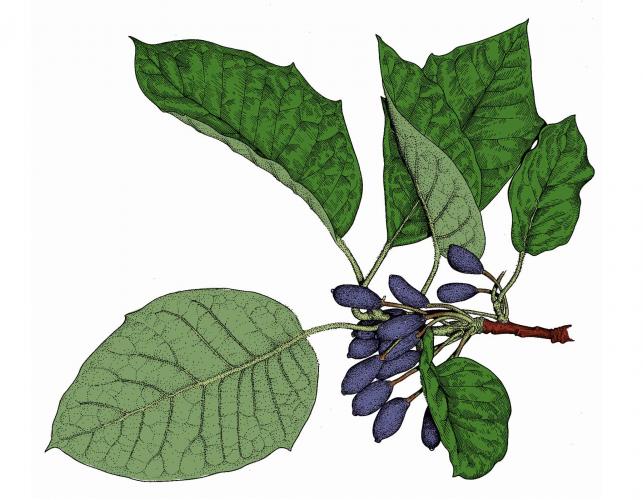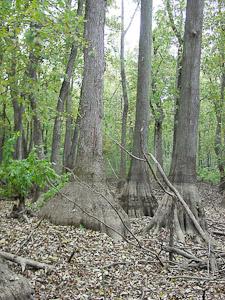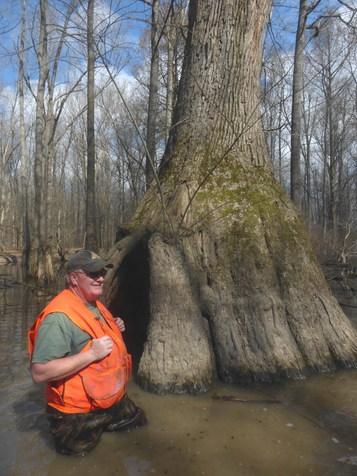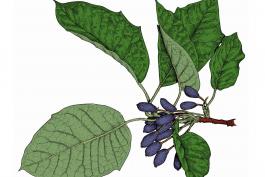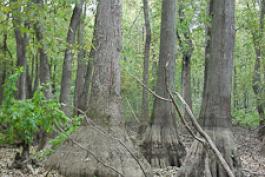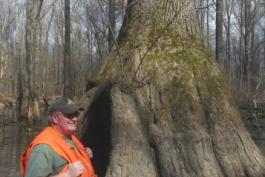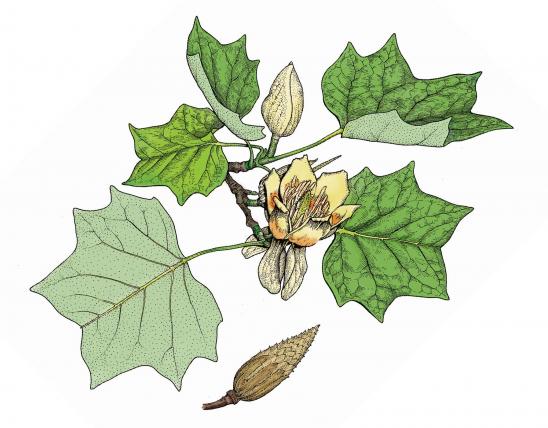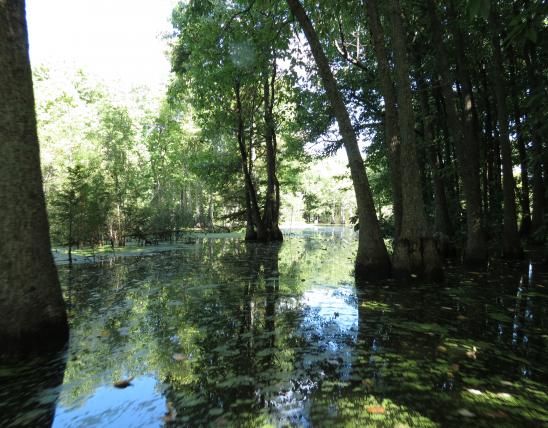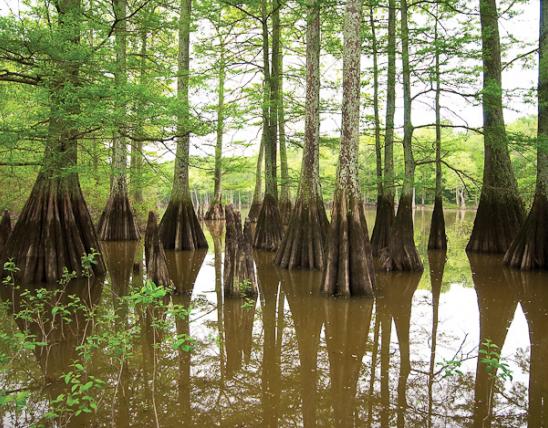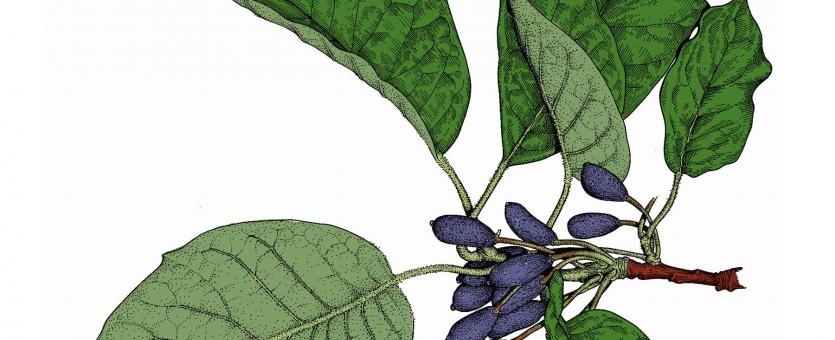
Water tupelo, or tupelo gum, is a large tree with a large, swollen, sometimes buttressed base, a tapering trunk, and a flattened, spreading crown. Its leaves may be up to 10 inches long and are often toothed. Water tupelo and bald cypress are the dominant trees in Missouri’s Bootheel swamps.
Leaves are alternate, simple, widest near the base to almost uniformly wide, 5–10 inches long, 2–4 inches wide; margins entire or irregularly toothed with a few coarse, broadly triangular, spreading teeth, tip abruptly pointed; upper surface dark green, leathery, smooth, not shiny; lower surface paler, finely hairy along the main veins; leaf stalks thick, hairy, 1–3 inches long. Leaves turn yellow in autumn.
Bark is grayish brown, relatively thin, with small grooves and scaly ridges.
Twigs are stout, dark red, hairy when young, becoming brown and smooth later. Pith is white, with chambers.
Flowers April–May, appearing as the leaves unfold, male and female flowers on separate trees; male flowers in rounded clusters on slender, hairy stalks; petals 5, dropping early; female flowers single on a slender, hairy stalk; petals 5, but much reduced.
Fruits September–October, on drooping stalks 3–4 inches long; fruit uniformly wide to widest at the top, about 1 inch long, purplish black when mature, skin thick, lightly dotted, flesh thin, very bitter; seed single, flattened, with long ridges, brown or white.
Similar species: Black gum, also called black tupelo (N. sylvatica), has toothless leaves whose blades are smaller (1½–6 inches long). The leaves turn bright red or purple in fall. Its trunk is not swollen (or is only slightly swollen) at the base and is never buttressed, and it has thicker bark. The fruit is only about ½ inch long. It is scattered to common in the Ozarks and Bootheel regions and occurs in bottomland forests, mesic to dry upland forests, savannas, swamps, sloughs, banks of streams, rivers, and spring branches, as well as in old fields and along railroads and roadsides. It usually occurs in acidic soils.
Height: to 115 feet.
Uncommon in the Bootheel lowlands and in adjacent southeastern portion of the Ozarks.
Habitat and Conservation
Occurs natively in southeast Missouri’s swamps, bottomland forests, sloughs, banks of streams and rivers, and sinkhole ponds, often as an emergent aquatic. You may also find it in cultivation, where people have planted it along the edges of ponds or lakes or other places with permanently moist to wet soils.
Tupelo gum is common in the southeastern United States in areas that are periodically flooded, in habitats where many other species cannot survive. In Missouri, it was a dominant species in the swampy forests of the Bootheel’s Mississippi Alluvial Basin before the nearly complete clearing and draining of that portion of the state for agriculture in the early 1900s. Its disjunct presence in a couple of upland sinkhole ponds in the southeastern Ozarks is remarkable.
Water tupelo and bald cypress trees rank as the most flood-tolerant large trees in temperate North America. Both once were commonly found throughout the Bootheel of Missouri. Today, only scattered populations of these trees and other swamp-related species remain in our state. The best example of a remnant swamp can be found at Allred Lake Natural Area in Butler County.
Status
Native Missouri tree.
Taxonomically, genus Nyssa has sometimes been placed into the dogwood family (Cornaceae). The current understanding is that the tupelos and about four other genera are distinct enough to deserve their own family, the Nyssaceae.
Life Cycle
Swamp tupelo trees are long-lived and begin flowering and fruiting when they are about 30 years old. Mature trees produce heavy seed crops every year that are mostly distributed by water. Seeds germinate on moist soil when water recedes in mid- to late summer.
Human Connections
Like other members of its genus, water tupelo is economically important as a timber tree, primarily in the southeastern United States. The light wood is used for plywood, boxes, pallets, furniture, flooring, paper pulp, fishing floats, and handicrafts. The massive, swollen portions of the lower trunks are especially prized by woodcarvers and are a traditional favorite for carving duck decoys; the wood is buoyant and doesn’t tend to split.
Water tupelo and its close relatives are prized as bee trees. Many contend that the best honey comes from the nectar of tupelo flowers. In the Florida panhandle, the favorite species for tupelo honey is the Ogeechee tupelo (N. ogeche), which does not grow in Missouri.
Water tupelo is an interesting native landscaping tree when planted along the edge of a lake or pond, where the soil is acidic and almost always saturated. It grows slowly but can live a long time.
The word tupelo is from the Muscogee language and roughly translates to “swamp tree.” The historic homeland of the Muscogee people (also called the Creek) is what is now the southeastern United States — the same region where water tupelo grows.
Ecosystem Connections
Often grows in colonies, often in association with bald cypress, which also develops swollen and/or buttressed trunk bases, and swamp privet (Forestiera acuminata), a shrub. Water tupelo and bald cypress are both adapted for life in standing water in swampy landscapes near big rivers, and both are the dominant trees in Missouri’s Bootheel swamp habitats.
At least 10 species of birds, including wood ducks, plus squirrels, raccoons, and deer, eat the fruits. Deer eat the leaves and twigs. The forest tent caterpillar (Malacosoma disstria) is at least one insect that feeds on the leaves of water tupelo.
The Missouri natural communities that water tupelo is part of are highly productive wetlands formed in the floodplain of the Mississippi River, which used to flood frequently and built up the deep soils of the Bootheel. After more than a century of people draining this land and cutting its trees, only about 2 percent of the original 2.4 million acres of wetlands now remain, in fragments, in the Bootheel region. These remaining fragments are the only places where many Missouri species occur in our state. For example, among the many fishes that spawn in Bootheel swamps are the brown bullhead, bantam sunfish, flier, starhead topminnow, and swamp darter. Other animals that live in these swamps are the three-toed amphiuma, alligator snapping turtle, western mudsnake, broad-banded watersnake, swamp rabbit, cotton mouse, and more. Numerous migratory birds rely on wetlands as they travel seasonally north and south through our state.
Globally, there are some 7 to 10 species in the tupelo genus.
